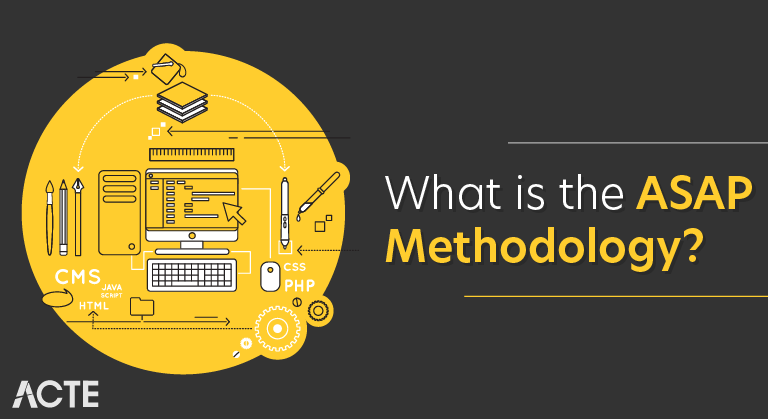
- ASAP Methodology is often known as “Accelerated SAP” is a standard SAP related Project preparation and implementation method. This methodology is developed and updated by the consultants who are in involved in implementing SAP software products. This methodology is also equally useful for the project managers and other individuals who are into implementing systems which cater to business support processes.
- The main purpose of ASAP or Accelerated SAP is to help project managers to design SAP implementation in an effective and efficient manner possible. This way we can assure that the time, quality, people and other resources are optimally utilized during this process.
- Using this process, i.e. ASAP methodology, project management provides a road map for effectively optimizing the implementation of SAP systems in the business processes. The solution that is developed will guarantee successful project solutions without compromising on the budget and the on-time delivery.
- This framework will provide different methods, tools, and templates that are originally developed for SAP projects. So using these within the project management will be definitely helpful.
The Accelerated SAP Methodology, i.e. ASAP Framework mainly consists of five different phases of implementation. Each phase of execution focuses on documentation, recommendations, and implementations of SAP systems. After each and every phase executed successfully quality check is carried out that will help the monitor to deliverable and also focus on vital factors which are crucial for success.
All the five different phases of ASAP methodology are listed below within detail explanation below:
- Project Preparation
- Business Blueprint
- Realization
- Final Preparation
- Go-live and support
This is more related to gathering information and required resources. This is a very crucial time where all the necessary components for implementation are gathered together. Some of the vital milestones that needed to be completed in the project preparation phase are:
- Get approval and support from Stakeholder
- Seek Senior level management approval
- Identify and define clear project objectives
- Work on an efficient decision-making process
- Work in an environment which is robust and it is suitable for change and re-engineering
- Last but not least, work on building a qualified and smart project team.
Within this phase, according to the SAP methodology, all suitable information on the company is gathered so that based on the necessary information gathered, the implementation process will be designed. Most of the time, these blueprints are in the form of surveys and questionnaires which will yield information about how the company does business in general.
In addition to this, they also document this process.
In the Business Blueprint documentation, it outlines the future business processes and the business requirements. These questions are categorized by only one business function. The following are sample questions:
What type of information is captured on a purchase order? What is the specific information that is required to complete the purchase order? Realization:This is the third phase of the process.
After successfully completing phase 1 and phase 2, “functional” experts will be available and start configuring SAP systems.
This phase is broken into two parts:- The SAP consulting team will help you to configure a baseline system, which is officially called a Baseline Configuration.
- As per the standard process, the implementation team will start fine-tuning the existing baseline configurations and make sure all the business needs and requirements are a part of the fine-tuning process.
As per the requirement provided in the Business Blueprint phase, baseline configuration is provided as per the Blueprint document. Further, the remaining 20% approximately is corrected within the fine tuning configuration.
Most of the time Fine tuning cannot be covered with the help of Baseline Configuration. Users have to make sure all of the remaining fine-tuning process.
Configuration Testing:- With the help of an experienced SAP consulting team, you can separate the business process into several cycles of related business flows. In turn, these cycles are referred to as independent units which can be used to test specific parts of the business process.
- In the process, you can also follow the standards mentioned in SAP implementation guide (IMG). This is a tool that can be used to assist while configuring your SAP system in a step by step manner.
Knowledge Transfer:
- Once the configuration phases come to an end, it is vital for the business or the project team to be self-sufficient in terms of the configuration knowledge of the SAP system.
- In order to get proper effective knowledge transfer, configuration team should be tasked with the system maintenance team ( an i.e. post-production team that is allocated to Go-Live condition) needs to be completed at this point of time.
- In addition, end-user training should also be scheduled so that they will be productive in day-to-day businesses purposes.
Final Preparation:
- This is a crucial part of the overall implementation.
- As the project team has gone through configuration steps and also the knowledge transfers phases, it is vital for the team to concentrate on the SAP training and should be involved in rigorous functional and stress testing. It should include both positive and negative process flow testing. This will help them to go through the entire functional flow of the product and at the same time they will be building up confidence over the tool.
- As the team is involved in testing, it will be a stage where a lot of last minutes fine-tuning will be designated and the configuration will be changed according to the needs. All this will happen before Go-live and more importantly, the data migration is also another important task that one has to give importance. Data migration from the old system to the SAP should be done effectively without any latency.
- Once the data is loaded it is vital for the team to conduct stress testing with actual valid data. Testing with peak volume data, daily load, and other forms of stress testing is very important and it is recommended. The integration and stress testing are important because it will validate the stability of the new system and also make sure that the data flow is also accurate.
- After all the data migrations and last minute fine tunings, it is time for preventive maintenance checks this will help the team to make sure that the SAP system is configured for optimum performance. After this activity, it is all about documenting the Go-Live strategy. At this point, it is more about preparing yourself to answer most of the questions from end users who are actively using the SAP system.
- Go-Live activity will be smooth and breeze if all the previous phases have been executed under strict monitoring process. If all the previous phases are not dealt with the way they were supposed to be then it is altogether a different ball game.
- Introducing a new system or tool or service to entire different individuals, in this case, preparation is the key. Within this preparation, one has to make sure that they have answered all the What If scenarios within the business processes and how is the tool or system is capable of answering or supporting in those situations.
- Further, processing maintenance contracts and documenting the overall Go-live process is vital in this phase.
- As per ASAP methodology, all the phases that we have discussed above covers the entire project life cycle from the start to post-project management. With the help of these phases, it helps the team to be transparent about the entire process and helps the overall execution to be smooth.
- It is a proven approach which facilities the project team to collaborate and work efficiently and effectively. Thus ultimately reducing the implementation costs and time and risks associated.
- Risk management is efficient. As the process goes through different phases and it gives an opportunity for the project team to understand and foresee any potential risks that would affect the entire project.
- Better knowledge management process. A phase is included where user training and last minute fine-tuning to the SAP configuration system is given priority, unlike other processes or methodology.
- This process yields better results because the project road map is executed with the help of experienced personnel.
- Project execution times are considerably less as compared to traditional project management.
- Usage of best practice tools, ITIL, PMI and Internal SAP.





